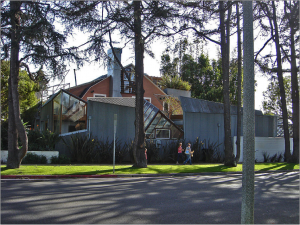
View from the street,
CC by IK’s World Trip, via Wikimedia Commons
Frank Gehry and his wife bought their private Santa Monica residence dating from the 1920s in 1977. It was a typical middleclass home in Los Angeles at the time it was build and did not differ much from the houses surrounding it. Gehry transformed the house into their home in a way that it was perceived as a strong statement at the time of its renovation.
According to Gehry, his wife Berta found and bought the house, already knowing that her husband would transform it into something new. But Gehry decided to keep the old house as it was and to add new elements to the exterior only, to clad it in a ‘Gehry-typical‘ manner, using characteristically ‘basic‘ materials like corrugated steel, glass, plywood and a chain-link fence. His strategy to destruct and break with the old forms of construction while still keeping it alive and visible by integrating it into his design is truly innovative.
Critics generally assume that he was deliberately trying to shock and provoke not only the critics, but the surrounding neighborhood with this ‘raw’ and ‘unfinished’ exterior – which he successfully managed. There were only few critics who appraised the building. Meanwhile most others, including the neighbors, were aggravated by the exterior Gehry aimed for, that just wouldn’t fit into the rather traditional surroundings, consisting of mostly one family houses with tidy front lawns inhabited by middleclass residents and which appears to be a calm and idyllic neighborhood.
The seemingly chaotic look of the buildings outside hides a rather cozy house, offering shelter and a private space, not in a cold avant-garde like style, but in a comfortable living atmosphere. This mirrors Gehry’s strategy of appearing to be a regular middleclass man in a regular middleclass house, while being an eccentric architect with a nonstandard home who disrupts the peace of his neighborhood, all in one.
Nevertheless, one can see some parts of the house’s interior from the street. Through the windows, people on the street can get a glimpse of the garden as well as the kitchen. The same goes for the inside: Here one cannot primarily see the surroundings of the house and gardens on street level, but rather the sky through slits in the walls or the lights of cars going by, reflecting in the glass roof over the dining room table. But this, of course, attracts views of passersby.
The architect himself states that the viewers only see what he wants them to see in his architecture. While something might be visible from one angle or position, it cannot be seen from another. Gehry’s private house is an example of this design strategy. Depending on where one is standing in the house, different areas of the surroundings are visible. The connection between inside and outside is very fluent, creating the illusion of standing outside while actually being inside the house. Gehry composes a view for the people outside without revealing too much of the private interiors.
He used his private house as a deliberate provocation and an experiment on how critics and other recipients would perceive it. The house received plenty of attention and constitutes the breakthrough of his career as an architect, and hence achieves what Gehry wanted it to.
From 1991-92 a second renovation took place during which a lot of the earlier ‘unfinished’ parts got transformed into their ‘finished’ versions, without much public attention.
Beatriz Colomina explains that the house, like its owner, is in constant flux and development, in a way that the both of them build and form each other to what they are now. Furthermore, she highlights how Gehry uses architecture and views to change and create the perception of the recipients.
Sources:
- Colomina, Beatriz: “The House That Built Gehry”, in: Frank O. Gehry, Mildred Friedman and Beatriz Colomina [i.a.]: Frank Gehry, Architect, New York 2001, p.300-320.
- Movie: Pollack, Sydney: Sketches of Frank Gehry, 2005.
Viola Menzendorff
